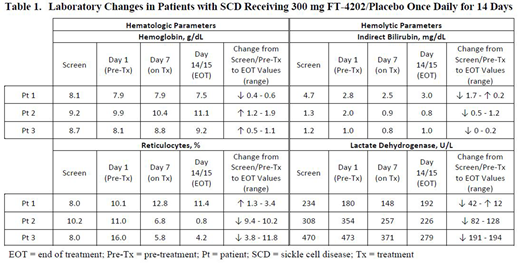INTRODUCTION: The hallmark of sickle cell disease (SCD) is hemoglobin S (HbS) polymerization upon deoxygenation, resulting in red blood cell (RBC) sickling, oxidative damage, membrane damage, hemolysis, cell adhesion, and vaso-occlusion. Exacerbating the pathogenesis of SCD, the HbS RBC has [1] increased (↑) 2,3-DPG with decreased (↓) O2 affinity (↑ P50) and [2] ↓ RBC ATP. FT-4202, a small molecule allosteric activator of erythrocyte pyruvate kinase (PKR), increases PKR activity resulting in ↓ 2,3-DPG levels and ↑ ATP levels in RBCs. In healthy volunteer (HV) studies (Kalfa et al. Blood 2019), FT-4202 was well tolerated, demonstrating physiologic responses (↓ 2,3-DPG and ↑ ATP) with biologic effects including ↑ O2 affinity, ↓ reticulocytes (P<.001) and ↑ Hb (ns). Based on the safety and pharmacokinetic/pharmacodynamic (PK/PD) profile in HV studies, FT-4202 is being evaluated in patients (pts) with SCD, first in a single dose (SD) cohort and then in multiple-dose (MD) cohorts (14-day and 12-week) [NCT03815695].
METHODS: In the SD and 14-day MD cohorts, pts with SCD were randomized 3:1 to FT-4202 or placebo. Safety assessments included treatment-emergent adverse events (TEAEs), vital signs, ECGs and laboratory parameters. PK/PD blood sampling was performed for up to 72h after the last dose and at the end-of-study visit; PD parameters included 2,3-DPG, ATP, P50, RBC deformability with controlled deoxygenation and reoxygenation (Lorrca® oxygenscan) and varying osmolality (Lorrca® osmoscan). To maintain study blind, pt identifiers were removed when needed.
RESULTS: As of 17-July-2020, the SD (700 mg FT-4202) cohort is complete and the 1st MD cohort (MD-1, 300 mg once daily) is enrolling. Unblinded data from the SD and blinded data from the MD-1, 3 pt safety lead-in (randomized 2:1) are summarized. No serious adverse events (SAEs) or TEAEs leading to pt withdrawal were reported. In the SD cohort, 7 pts (2 males, 5 females, all HbSS) received 700 mg FT-4202 (n=5) or placebo (n=2). Six transient Grade 1 TEAEs occurred in 4 of 7 (57%) pts, including 3 TEAEs (arthralgia, headache, palpitations) in 2 of 5 (40%) pts receiving FT-4202 and 3 TEAEs (back pain, myalgia, pruritis) in 2 of 2 (100%) pts receiving placebo. RBC ATP concentrations increased by 30% and RBC 2,3-DPG concentrations decreased by 26% 24h after FT-4202. Increased O2 affinity (↓P50) with a decreased point of sickling (PoS) and improved HbS RBC deformability were observed in all FT-4202-treated pts. Improved HbS RBC membrane function was also demonstrated with a shift of the osmoscan results towards normal. Improved hematologic parameters, including ~0.9 g/dL Hb increase compared with placebo, were also observed 24h after a single dose of FT-4202. In 3 pts with SCD (3 females, all HbSS) who thus far completed MD-1, 14 days of 300 mg FT-4202 or placebo daily was well tolerated, with 1 pt reporting transient, unrelated Grade 2 TEAEs of nausea/vomiting at the end of the 14-day dosing period. Laboratory changes relative to pretreatment for each pt are shown in Table 1. In 2 of 3 SCD MD-1 pts treated with FT-4202/placebo (currently blinded), Hb increased by > 1 g/dL, % reticulocytes decreased, and markers of hemolysis were improved after 14 days of treatment (compared to pre-treatment levels). Hematologic parameters returned to pre-treatment levels 4 to 7 days post-treatment (data not shown) without clinical AEs. Functional studies in the 2 pts with increased Hb showed improved RBC deformability (↓ PoS) and improved RBC membrane function while on study treatment relative to pre-treatment and/or post-treatment.
CONCLUSION: FT-4202 has a favorable safety profile in pts with SCD receiving a single dose or up to 14 days of dosing. A single dose of FT-4202 led to decreased 2,3-DPG and increased ATP, resulting in increased O2 affinity, decreased PoS, improved RBC deformability, and improved RBC membrane function. Initial blinded results of daily dosing with 300 mg FT-4202/placebo over 14 days show improvement in both hematologic and hemolytic parameters in 2 of 3 pts with SCD, along with improved RBC functional studies, suggesting the pharmacodynamic consequences of PKR activation may be of clinical benefit in SCD. Multiple-dose cohorts are ongoing to further evaluate the safety, PK/PD, and biological activity of FT-4202 following daily administration in pts with SCD; updated data will be presented.
Brown:Imara, Inc.: Consultancy, Research Funding; Forma Therapeutics, Inc,: Research Funding; Global Blood Therapeutics: Membership on an entity's Board of Directors or advisory committees, Research Funding; Novartis, Inc.: Consultancy, Research Funding. Kalfa:Agios Pharmaceuticals, Inc: Consultancy, Research Funding; Forma Therapeutics, Inc: Research Funding. Kuypers:Forma Therapeutics, Inc.: Research Funding. Saraf:Global Blood Therapeutics: Membership on an entity's Board of Directors or advisory committees, Other: Advisory Boards, Speakers Bureau; Novartis, Global Blood Therapeutics: Membership on an entity's Board of Directors or advisory committees; Pfizer, Global Blood Therapeutics, Novartis: Research Funding. Estepp:Global Blood Therapeutics, Forma Therapeutics, Pfizer, Eli Lilly and Co: Research Funding; Daiichi Sankyo, Esperion, Global Blood Therapeutics: Consultancy; ASH, NHLBI: Research Funding. Malik:Aruvant Sciences, CSL Behring: Patents & Royalties; Aruvant Sciences, Forma Therapeutics, Inc.: Consultancy. Ribadeneira:Forma Therapeutics, Inc.: Current Employment. Forsyth:Forma Therapeutics, Inc.: Current Employment. Schroeder:Forma Therapeutics, Inc.: Current Employment. Wu:Forma Therapeutics, Inc.: Current Employment. Kelly:Forma Therapeutics, Inc.: Current Employment. Telen:Forma Therapeutics: Research Funding; GlycoMimetics Inc.: Consultancy; Pfizer: Consultancy, Membership on an entity's Board of Directors or advisory committees, Research Funding; CSL Behring: Membership on an entity's Board of Directors or advisory committees, Research Funding; Novartis: Consultancy, Membership on an entity's Board of Directors or advisory committees.
Author notes
Asterisk with author names denotes non-ASH members.


This feature is available to Subscribers Only
Sign In or Create an Account Close Modal